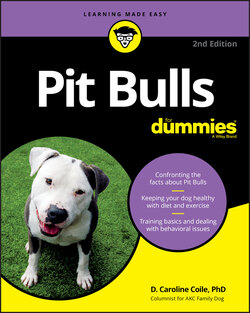Читать книгу Pit Bulls For Dummies - D. Caroline Coile - Страница 15
FIGHTING WORDS
ОглавлениеAlthough dog fighting is illegal in the United States, it does occur — and it even has rules! Understanding how a traditional match was (and still is) conducted is — no matter how unsavory — essential to understanding the way Pit Bull breeding stock were selected for generations.
In the heat of battle, the dogs must discriminate between biting another dog and biting a human. Before a fight begins, each dog is washed by the opponent’s handler to make sure that no drugs or toxic or foul-tasting substances are on the dog’s coat. Otherwise the other dog would get the substances in his mouth. The dog is then dried and carried to his corner. During the fight, a referee and the two handlers remain in the ring with the dogs. The handlers sometimes kneel right beside the dogs; they are allowed to urge their dogs on but not to touch them. If a dog becomes “fanged” (that is, if its canine tooth pierces its own lip), the handlers hold both dogs while the referee tries to push the tooth back through the lip with a stick or other utensil. The dogs are then released a few feet from each other.
True fighting dogs are eerily silent. Barking, growling, snarling, and showing teeth are threat displays that most dogs use in an attempt to discourage an opponent before a fight begins. Most dogs are more show than go, and fighting consists largely of bluffing the other dog into submission. Not so with a fighting Pit Bull. He is more likely to whine with excitement.
If one of the fighting dogs turns away from the other, the referee calls a “turn” and both handlers retrieve their dogs and take them back to their corners. The dog who turned is then released and expected to “scratch,” meaning to cross the pit and attack the other dog within ten seconds. The dogs continue to take turns being released first every time one dog turns. The dog may crawl, stagger, or drag himself toward the other dog as long as he doesn’t stop or hesitate. A dog who fails to scratch loses the match, and perhaps his life, as he is considered to lack gameness. A dog who is losing, but nonetheless attempts to scratch, might lose the match but may return to fight another day if his handler concedes the match.
The UKC fancied up the breed’s name by calling it the American (Pit) Bull Terrier, later changing the name to the now accepted American Pit Bull Terrier. Because the breed’s roots are mostly European, and the Pit Bull may or may not have terrier influences, the name is somewhat of a misnomer.
The first American (Pit) Bull Terrier to be registered with the UKC was Bennett’s Ring, owned by UKC founder Chauncey Bennett.
In 1909, Pit Bull proponents organized yet another registry, the American Dog Breeder’s Association (ADBA). The ADBA registers only one breed: the American Pit Bull Terrier (APBT). The ADBA was traditionally the registry of fighting Pit Bulls. Although it no longer endorses dog fighting, it maintains that reputation. The ADBA instead now sponsors conformation shows and popular weight pulling contests.
